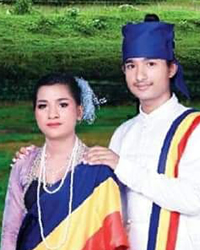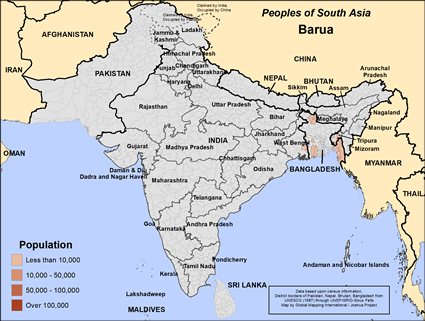The name Barua is derived from two words, bara meaning 'renowned ', and ua meaning 'ruler '. In ancient times, the most highly ranked military ruler of Chattagram under the king of Arakan was a man called Barua. Those living in Bangladesh as well as in parts of India speak Chatgaiyan (i.e. Chittagonian), a dialect of Bengali which has a similarity to Burmese, Assamese and Bengali, in vocabulary, phonology as well as enunciation. The Barua ethnic group lives in the north-east India state of Tripura. A larger number are further east in Bangladesh and in Myanmar.
After Barua women marry they wear vermilion and conch-shell bangles as marriage symbols and as a sign of their unavailability to men. 'Residence after marriage is patrilocal. Although either spouse can seek divorce, its incidence is rare. Nowadays, the practice of paying bride-price in cash is being replaced by that of dowry. ' Traditionally the Barua earned their livelihood through farming, fishing and hunting. As waves of migrants have entered Tripura the number of wild animals has diminished, making hunting a fruitless exercise unless the participants are willing to trek deep into the forests. The Barua raise goats and chickens today as their main sources of protein. In the past 20 years, as education levels among them have improved, a number of Barua men and women have obtained jobs as office workers, teachers and administrators.
The Barua are now allowed to marry people from non-Buddhist communities such as the Brahmin, Kayastha and Magh. There are no known Christians among this interesting and unique unreached people group.
Almost all Bengalis are Hindus or Muslims. For unclear historical reasons, the Barua have survived as a Buddhist enclave in the midst of the two giants of Islam and Hinduism. Most likely, their Buddhist beliefs are being replaced by Hindu ones. Just how the Barua once came to believe in Buddhism, and equally how they have managed to preserve their faith under pressure from all sides, is difficult to ascertain because they have no written history.
The Barua people need someone to introduce them to the Lord of lords so he can bless their communities and families.
Pray for God to show himself powerful and loving by providing for their needs.
Pray that the Barua people will have a spiritual hunger that will open their hearts to the King of kings.
Pray for workers who are driven by the love and boldness of the Holy Spirit to go to them. Pray for a movement to Christ among them to begin soon.
Scripture Prayers for the Barua in India.
Peoples of the Buddhist World, Asia Harvest, Copyrighted © Used with permission
| Profile Source: Joshua Project |











